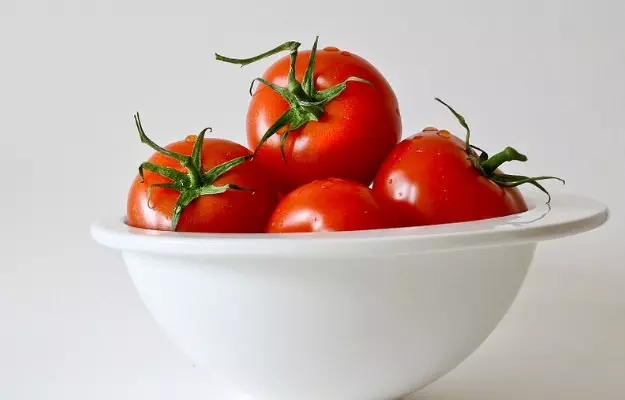It is impossible to miss the deep red colour of a Tomato, consumed in diverse ways - raw or cooked, grating it into a salad or blending it into soups. Being an excellent source of nutrients, it is considered a superfood as people would like to include it in preparations of almost all dishes. From juices to salads to cooked recipes, a tomato is extensively used for its colour, antioxidants, and flavours. In fact, the tomato has been designated as the state vegetable of New Jersey. Many people consider tomato as one of those special foods which make our heart flutter.
Easy to grow, tomatoes have become a more and more popular crop worldwide. Tomato plant originates from the family of nightshade plants (potato, tobacco, chilli, and peppers) from Central America, more specifically from Peru. In the mid-1500s, tomatoes first came to Europe. Today, they are the fourth most sought-after fresh-market vegetables; potatoes, lettuce and onions being the first three. It is speculated that there are over 25000 tomato varieties. It also has wonderful medicinal properties. Tomatoes are of different sizes and colours, and can be prepared in a number of ways. Very delicious and flavourful in nature, most people can’t imagine food without tomatoes.
Interestingly, Americans obtain more vitamins from tomato than from any other vegetable. It is green in nature when it is unripe and turns its colour to red when it ripens. As the tomato has seeds and grows from a flowering plant, botanically it is classified as a fruit, not a vegetable. They are used a lot in Italian food and to make ketchup, of course. Also, it is a key ingredient in many Indian recipes. Tomato gets its red colour from the presence of carotenoids in it. But they are not only in red colour, but you can also find them in yellow, pink, purple, black and white colours.
China is the largest producer of tomatoes, accounting for one-quarter of the world production in 2009. The United States and India are the second and third highest producers respectively. According to the Guinness Book of World Records, the heaviest tomato weighed 3.51 kg and was grown by G. Graham in 1986, Oklahoma, USA. Tomatoes help people to fight cancer, maintain blood pressure and reduce blood glucose in people with diabetes. They work fabulously as a blood filter and exceptionally well in removal diets.
Not only for the health, but the tomato is also very beneficial for the skin as it protects it from sunburns.
Basic facts about Tomato
- Kingdom: Plantae
- Family: Solanaceae
- Class: Dicotyledonae
- Scientific name: Solanum lycopersicum
- Origin: In literary terms, the English word ‘tomato’ as we call it, comes from the Spanish word, ‘tomate’, which means "the swelling fruit". Botanically, the tomato plant originated somewhere in or around Peru, in Central America. It is believed that it was first grown by the Aztecs (one of the earliest tribes of America) in 700 A.D.
- Group: Dicots
- Other Common names: Tomate (French), Tamatar (Hindi), Pomodoro (Italian)
- Fun Fact: Each year in the Spanish town of Bunol, the biggest tomato fight in the world happens. The festival is known as La Tomatina and it involves around 40,000 people throwing more than 1,50,000 tomatoes at each other.
Nutritional facts of tomato
Tomatoes contain lycopene, a powerful cancer fighter. They are also rich in Vitamin C. Tomatoes also help in improving calcium and other mineral concentration in the bones and makes them strong. It is very effective in healing fractured bones. The water content of tomatoes is around 95% and the other 5% is carbohydrate and fibre. Rich in potassium, folate and vitamin C, the tomato is very beneficial for both the body and mind and has proven to be effective in eradicating many health diseases. This food has negligible saturated fats and no cholesterol. Besides being rich in nutrients like vitamins, minerals, protein and fibre, tomatoes are also low in calories.
According to the USDA National Nutrient Database, 100g of tomato contains the following values:
|
Nutrient |
Value per 100g |
|
Water |
94.78 g |
|
Energy |
16 kCal |
|
1.16 g |
|
|
Fats |
0.19 g |
|
3.18 g |
|
|
0.9 g |
|
Minerals |
Value per 100 g |
|
5 mg |
|
|
Iron |
0.47 mg |
|
Magnesium |
8 mg |
|
Phosphorus |
29 mg |
|
Potassium |
212 mg |
|
Sodium |
42 mg |
|
Zinc |
0.14 |
|
Vitamin |
Value per 100 g |
|
Vitamin B1 |
0.046 mg |
|
Vitamin B2 |
0.034 mg |
|
Vitamin B3 |
0.596 mg |
|
Vitamin B6 |
0.060 mg |
|
Vitamin B9 |
29 µg |
|
16.0 mg |
|
|
75 µg |
(Read more - Vitamin B benefits and sources)
|
Fats/ Fatty acids |
Value per 100 g |
|
Total unsaturated |
0.025 g |
|
Total monounsaturated |
0.028 g |
|
Total polyunsaturated |
0.076 g |
Health benefits of tomato
Tomato for a healthy skin
In the present era, people are very concerned about their skin. Everybody wants a clear and smooth skin. Dermatologists and experts say that eating habits have a major influence on it. Eating fresh vegetables and fruits can majorly affect the skin. Tomato is considered one of the vegetables that have a positive impact on it. Rich in lycopene and other plant compounds, it protects the skin from sunburns.
Lycopene is a major carotenoid and is a very efficient singlet oxygen scavenger. Following the ingestion of lycopene or a tomato-derived product rich in lycopene, photoprotective effects have been demonstrated. Dietary carotenoids may contribute to a life-long protection against harmful UV radiation. The reference data suggests that it is feasible to achieve protection against UV-light induced erythema by consumption of a dietary source of lycopene.
Tomato for bones
Tomato is beneficial in maintaining healthy bones and teeth. Tomato is rich in the antioxidant lycopene which results in the decrease of oxidative stress and has a positive impact on bone health. It also contains all four carotenoids and these carotenoids may immensely benefit the bones.
Tomato for eyesight
Rich in vitamin A and beta-carotene, the tomato is not only good for the skin and human health, but also for improving vision. It is required to keep the retina working correctly and for low light and colour vision. It plays a major role in the development of the eyes.
Tomato for hair loss
Hair loss is one of the most common problems found, especially in women. Basically, during the period of menopause, the hormones status changes which in turn results in hair loss. Rich in vitamin A, tomato works perfectly to keep the hair shiny, smooth and healthy. (Read more - Hormonal imbalance treatment)
Tomato for diabetes
One can include tomatoes in their diet to naturally control blood sugar. Tomatoes are known to contain a mineral called chromium. This mineral works well in regulating blood sugar. In a quasi-experimental study, 32 Type 2 diabetes patients received 200g of raw tomato daily for 8 weeks. A significant decrease in blood sugar was observed at the end of the study. Thus, the consumption of raw tomatoes on a daily basis proves to be effective for the diabetic patients in order to control blood sugar. (Read more - High blood pressure symptoms and treatment)
Tomato prevents cancer
Cancer is the second worldwide cause of death and is becoming a very common disease. Cancer is caused when abnormal cells divide in uncontrolled ways. Cancer can be of many types - breast cancer, lung cancer, lymphoma, etc. Doctors suggest that eating the right amount of food can reduce the risk of cancer. Tomatoes are one of the foods which help in reducing the risk factors for cancer. Lycopene belongs to the carotenoid family which is found in abundance in tomatoes. It has been believed that lycopene is a strong antioxidant which lowers the risk of cancer. It accounts for almost 90% of total carotenoids in a tomato. Electronic searches were conducted across MEDLINE, EMBASE, and the Cochrane central register of controlled trials databases.
A clinical study in women shows that high concentrations of carotenoids found in high amounts in tomatoes may protect against the development of breast cancer.
Tomato for a healthy heart
Cardiovascular diseases include heart attack and stroke which have increasing cases nowadays. With day-to-day changes in the food habits of the people, chances of heart diseases are also increasing. Generally, people are more inclined towards high-calorie foods which have a tendency to lead to heart attack. Presence of lycopene in tomatoes reduces the chances of heart diseases. Lycopene also helps in reducing intracellular total cholesterol. Lycopene and tomato products decrease plasma total cholesterol, LDL (bad cholesterol), and increase high-protein lipoproteins (good cholesterol). The experimental result shows dietary supplementation with lycopene and other tomato products reduce plasma LDL depending on the dose and the time of administration.
Tomato for asthma
Tomato acts as the latest superfood to help the asthmatic patient out of the hospital. According to a study, antioxidants from tomatoes helped people in having a much stronger immune response when exposed to the common cold virus. Antioxidant-rich diet is associated with reduced asthma prevalence. With the consumption of a low antioxidant diet, plasma carotenoid concentrations decrease, thus attributing to an increased prevalence of asthma.
Tomato for constipation
As discussed earlier, tomato contains 95% water and the remaining 5% is fibre and carbohydrates. Thus, the tomato is a rich source of water and fibre. Both these nutrients have great potential to improve digestion. Dietary fibre also affects stool bulk and its transit time. The issue of constipation is very common in adults and even youngsters face this problem nowadays. Simply eating a tomato can help people to get rid of constipation. A research study also shows that because of the fibre content, usage of tomato in food preparations improves well-being.
Side effects of tomato
- Tomatoes are highly acidic in nature which can cause heartburns. Enriched with citric acid, tomatoes produce excessive gastric acid. Not only raw but cooked tomatoes may also lead to heartburns. In salads, raw tomatoes are always included and daily consumption of tomatoes increases the volume of acid which is forced to flow up the oesophagus causing a condition called gastro-oesophagal reflux. However, this is not a very common phenomenon.
- Tomatoes are rich in vitamins, minerals and other nutrients but still cause allergies, hives, and rashes on the skin. Tomato contains a compound called histamine that can cause allergic reactions. Allergic reactions such as itching, swelling, red patches around the eyebrows and eyelashes, etc. are common occurrences among those who get affected. Sometimes in order to get glowing skin, tomatoes are scrubbed on the skin directly and if they turn out to be bad tomatoes, they may lead to these allergic reactions.
- The kidneys help us in filtering blood and removing toxins from the body. Kidney issues occur when any one or both the kidneys lose their ability to filter waste from the blood sufficiently. According to the department of health and human services, USA, if a person is already suffering from a kidney disorder, they can limit their intake of tomatoes as it contains high amounts of oxalate which is responsible for the formation of kidney stones (calcium oxalate stones). Any product made up of tomato should be avoided by the person suffering from kidney diseases.
- When the compound named histamine present in the tomato is released into the body tissues, it causes joint pain. Tomatoes also contain alkaloids called solanine which build up calcium in the tissues and cause inflammation. Thus, it can also cause arthritis-like conditions in some people.
Takeaway
Now, we know that tomatoes are a rich source of vitamins, minerals, calcium, potassium, etc. It can be classified as one of the easiest and healthiest vegetables to eat. It is available throughout the year and has several health benefits. Although tomato is rich in minerals and vitamins, it cannot provide everything that our body needs. As every fruit has its own pros and cons, so does a tomato. Yet, you shouldn’t hesitate to include it in your diet.
Medicines / Products that contain Tomato
- Girkoplex Oral 400 ML - ₹60
- Hawaiian Herbal Lycopene Capsule-Get 1 Same Drops Free - ₹999
- Jiva Carrot Cream - ₹100
- Jiva Grape Seed Mask - ₹105
- Cureveda Grow Plant Biotin Advanced Hair Nutrition Powder - ₹995
- Swisse Ultivite Mens Multivitamin Tablet - ₹2349
- Himalayan Organics Plant Based Biotin Powder 10,000mcg from Sesbian Grandiflora - ₹612
- Truceuticals Nanoceutical Vitamin C Drops 50ml - ₹270
- Hawaiian Herbal Forever Pro 6 Capsule-Get 1 Same Drops Free - ₹999
- Hawaiian Herbal Rhodiola Rosea Capsule-Get 1 Same Drops Free - ₹999
- Hawaiian Herbal Concentrated Fruits and Vegetables Capsule-Get 1 Same Drops Free - ₹699
References
- United States Department of Agriculture Agricultural Research Service. Basic Report: 11695, Tomatoes, orange, raw. National Nutrient Database for Standard Reference Legacy Release [Internet]
- Sato R et al. Prospective study of carotenoids, tocopherols, and retinoid concentrations and the risk of breast cancer. Cancer Epidemiol Biomarkers Prev. 2002 May;11(5):451-7. PMID: 12010859
- Palozza P et al. Effect of lycopene and tomato products on cholesterol metabolism. Ann Nutr Metab. 2012;61(2):126-34. PMID: 22965217
- Stahl W et al. Dietary tomato paste protects against ultraviolet light-induced erythema in humans. J Nutr. 2001 May;131(5):1449-51. PMID: 11340098
- Debjit Bhowmik. Tomato-A Natural Medicine and Its Health Benefits . Journal of Pharmacognosy and Phytochemistry
- Assunta Raiola et al. Enhancing the Health-Promoting Effects of Tomato Fruit for Biofortified Food . Mediators Inflamm. 2014; 2014: 139873. PMID: 24744504
- Wood LG et al. Lycopene-rich treatments modify noneosinophilic airway inflammation in asthma: proof of concept. Free Radic Res. 2008 Jan;42(1):94-102. PMID: 18324527
- Sturtzel B, Mikulits C, Gisinger C, Elmadfa I. Use of fiber instead of laxative treatment in a geriatric hospital to improve the wellbeing of seniors. J Nutr Health Aging. 2009 Feb;13(2):136-9. PMID: 19214342
- Lesley B Dibley, Christine Norton, Roger Jones. Don't eat tomatoes: patient's self-reported experiences of causes of symptoms in gastro-oesophageal reflux disease. Family Practice, Volume 27, Issue 4, August 2010, Pages 410–417,
- Merckmedius. Allergy symptoms: Hives, rashes and swelling. Adult Health Advisor 2009.4: Wound Closure and Wound Care: D. Allergies and Hives, 2009
- University of Chicago Kidney Stone Evaluation and Treatment Program. How To Eat A Low Oxalate Diet. University of Chicago
















